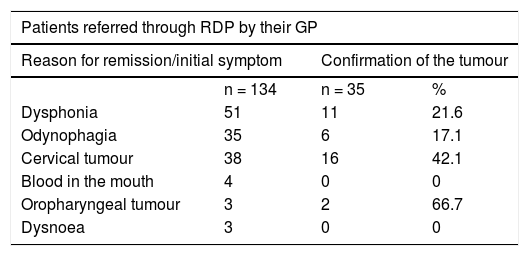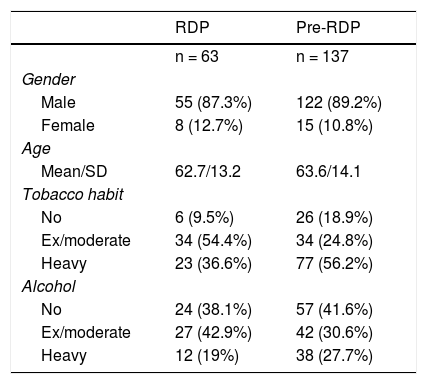: Given the epidemiological knowledge of squamous cell carcinomas of the head and neck (SCHN), the prognosis in survival according to the staging at diagnosis and the absence of screening programmes that have proven cost-effective, we undertook a rapid diagnosis programme. The objective of this study was to analyse whether a rapid diagnostic programme (RDP) to be used by General Practitioners (GP) would achieve a change in the proportion of diagnoses in early versus late stages in these tumours.
MethodsA prospective observational study of patients diagnosed with a tumour of ENT location in our centre, was carried out for 24 consecutive months. A “suspicion algorithm” was designed and we established a rapid remission route for these patients. The data obtained (age, sex, toxic substance consumption, initial manifestations, tumour location and extension) were compared with the data of the patients in our ENT Service database diagnosed in the four years prior to the start of the study.
Results199 patients were included, and 82 ENT tumours diagnosed. The GPs sent to the Hospital via the RDP a total of 136 patients and 35 (26.1%) had a tumour. However, most of the tumours diagnosed in this period by our ENT Department (47 patients, 57.3% of all tumours diagnosed), were not suspected by the GP and were not sent via the RDP.
Of the patients, 27% were diagnosed in stages I and II, and 73% in stages II and IV, there were no significant differences with the control group. The most frequent initial signs and symptoms were dysphonia, cervical mass and dysphagia, the relationship between initial symptom and stage at the moment of diagnosis was analysed, and in neither case did we obtain any significant variation.
ConclusionsThe implementation of a rapid diagnosis pathway for patients who, according to the algorithm created, had a suspected head and neck cancer, has not led to an increase in the diagnosis of these tumours in early stages or a decrease in diagnoses in advanced stages.
Dado el conocimiento epidemiológico del carcinoma escamoso de cabeza y cuello, pronóstico y supervivencia según el estadio al diagnóstico, y ante la ausencia de programas de cribado que hayan demostrado ser coste-efectivos, nos propusimos evaluar un programa de diagnóstico rápido. El objetivo del presente estudio fue analizar si la existencia de un circuito de diagnóstico rápido desde atención primara, en base a una ponderación de síntomas y signos, supondría un cambio en la proporción de diagnósticos en estadios iniciales versus tardíos en estos tumores.
MétodosSe ha realizado un estudio observacional prospectivo de pacientes remitidos con la sospecha de un tumor en el área ORL en nuestro centro durante 24 meses consecutivos. Se creó un algoritmo con síntomas y signos de sospecha para utilización por el médico de familia y un circuito de remisión rápida de los pacientes candidatos. Se registraron también los pacientes con sospecha de tumor provenientes de fuentes distintas a este circuito. Los datos obtenidos (edad, sexo, consumo de tóxicos, tiempo y clínica de presentación, localización del tumor y extensión), se han comparado con los de los pacientes recogidos en la base de datos de tumores del Servicio ORL diagnosticados durante los cuatro años previos al inicio del estudio.
ResultadosSe incluyeron en el estudio 199 pacientes y se diagnosticaron 82 tumores del área ORL. Los médicos de familia remitieron por el circuito de diagnóstico rápido creado un total de 136 pacientes y 35 (26,1%), presentaban una tumoración. Sin embargo la mayoría de tumores diagnosticados durante este período en el Servicio ORL (47 pacientes, 57,3% de todos los tumores diagnosticados), no fueron sospechados por su MF y no fueron remitidos al Hospital utilizando el circuito de diagnóstico rápido.
Un 27% de los pacientes fue diagnosticado en estadios I y II, y un 73% en estadios III y IV, no hubo diferencias estadísticamente significativas con el grupo control, y tampoco en los porcentajes de tumores recibidos por localizaciones (laringe, faringe, cavidad oral, primario desconocido, otros).
Los síntomas iniciales más repetidos fueron la disfonía, la aparición de una masa cervical y la odino-disfagia. Se analizó la relación entre el síntoma inicial y el estadio al diagnóstico. En ninguno de los casos se obtuvieron diferencias significativas respecto al grupo control.
ConclusionesLa puesta en marcha de un circuito de atención rápida a los pacientes que según el algoritmo creado tenían una sospecha de padecer cáncer de cabeza y cuello, no ha supuesto un aumento de los diagnósticos en estadios precoces y una disminución de los diagnósticos en estadios avanzados en nuestro centro.













